Valencia: the most embarrassing MotoGP victory in history?
What does it say when your MotoGP bike wins its last race before you park it in the museum and shut down your project? Suzuki’s fairy-tale Valencia victory was bittersweet, whereas Ducati’s long-awaited second MotoGP crown was pure sweetness.
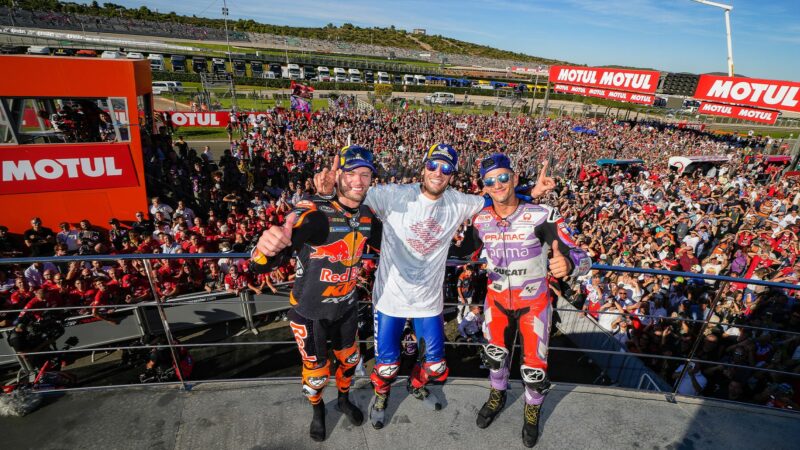
Winner Rins shares the podium with runner-up Binder and Martin
Dorna
“The past is a foreign country: they do things differently there,” wrote someone a while back. They were correct but history was inextricably linked with the remarkable events that unfolded at the MotoGP Valencia finale on Sunday.
Valencia had a weird half-century vibe about it, cast a blinding spotlight on the changing nature of motorcycle grand prix racing.
Ducati won the 2022 MotoGP world title 50 years after the company’s very first MotoGP bike scored its first MotoGP podium at the 1972 Italian grand prix at Monza.
And for the first time in history non-Japanese motorcycles scored 15 victories in a MotoGP season (12 to Ducati, two to KTM and one to Aprilia) bettering Europe’s best of 12 victories in one year, achieved by MV Agusta, yes, you guessed it, 50 years ago in 1972.
And then there was Pecco Bagnaia’s and Ducati’s MotoGP championship success, the first time an Italian rider and Italian motorcycle have won the premier-class world championship in 50 years, since Giacomo Agostini won the last of his seven consecutive MotoGP titles with MV Agusta… in 1972. This was also Ducati’s first title since Casey’s Stoner’s in 2007.
And Suzuki said a fairytale winning goodbye to MotoGP 50 years after it had one motorcycle on the first-ever all-Japanese MotoGP podium (Yamaha 351cc twin, a Kawasaki 500cc triple and a Suzuki XR05-powered 500cc twin) at the 1972 Spanish GP at Montjuïc, Barcelona.
And finally there was some good old-fashioned Valentino Rossi serendipity to Bagnaia’s title victory, ten years after the youngster’s mentor had gladly ended his two grim years with Ducati. Rossi’s career was full of moments when the planets aligned, like when (against the odds) he won Honda’s 500th GP victory in the premier-class at the company’s own circuit, Suzuki, in 2001. This time the first-ever VR46 academy MotoGP world champion was crowned exactly one year after Rossi took the MotoGP chequered flag for the last time. You couldn’t make it up.
After all that, Alex Rins’ and Suzuki’s brilliant and unexpected farewell victory at Valencia may just be the most embarrassing grand prix win in history.
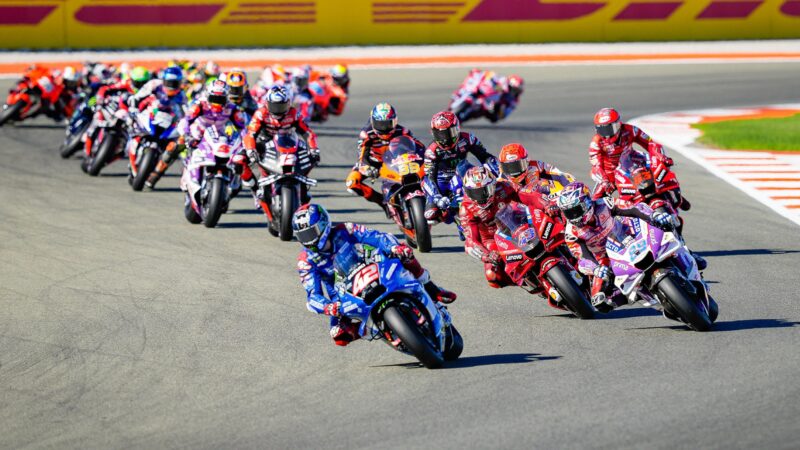
Rins got the holeshot and never lost the lead – it’s lap one and he’s chased by Martin and Miller, who later fell
Dorna
Try to imagine the scenes around the Suzuki boardroom table in Hamamatsu today as Suzuki management look wide-eyed through the global coverage of Rins’ success aboard their brilliantly conceived MotoGP bike that will soon be gathering dust in the company foyer.
So many headlines must read something like this: “Victory for Suzuki but what the hell are they doing?!”
Suzuki’s exit is a massive shame and a huge loss to MotoGP, for sure.
Of course, Suzuki has been here before. It is not the first time that it has walked away from the world’s premier motorcycling world championship. The company left at the end of 1983, when its RG500 two-stroke was well past its sell-by date, and after the 2011 season, when its GSV-R four-stroke project was struggling so badly.
The logic on both those occasions was pure racing thinking – let’s get out of here and go back to the factory to spend the next few years building something faster.
Not this time. The times they are a ‘changing and Suzuki is changing with them. Very soon the company’s legendary range of sportbikes – the GSX-R1000, GSX-R750 and GSX-R600 – will no longer be available in showrooms in various parts of the world because so-called crotch-rockets have had their day as a market force. They will be replaced by adventure bikes – the market sector where it’s all currently all happening – plus cheaper middleweights and lightweights and, of course, electric bikes. Because we live in a poorer, more uncertain world.
Rins’ fifth victory from his six years with Suzuki was stunning. His start was astonishing, rocketing away from the second row of the grid to out-drag the V4s of front-row starters Jorge Martin, Marc Márquez and Jack Miller into the first corner.
And that was that. Over the entire 27 laps the 26-year-old Spaniard never let anyone get close enough to even get a sniff of an overtaking opportunity, even though he had the rocketship-fast Ducatis of Jorge Martin and Jack Miller chasing him for most of the race.
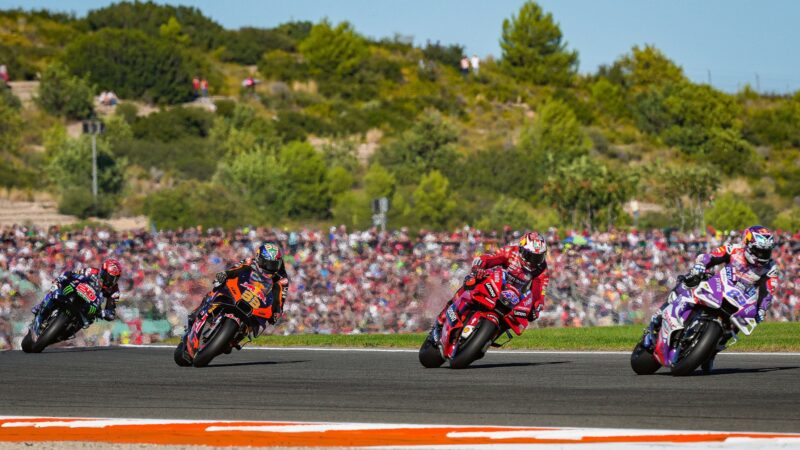
The podium battle: Martin, Miller, super-quick Binder and Quartararo
Dorna
Valencia isn’t a great track for overtaking, unless you’ve got an awesome engine. The start/finish is long – 0.455 miles (0.9km) – with riders exiting Turn 14 at 40mph (65km/h) and hitting the brakes for Turn One at over 200mph (321km/h), so it’s pretty much the biggest acceleration of the championship, where brute power is nearly everything, plus anti-wheelie front downforce and electronics.
Pole-starter Martin, always Rins’ biggest threat until hard-charging Brad Binder passed him with two laps to go, did have a top-speed advantage over Rins, but so successful was Suzuki’s engine work for 2022 that Martin’s Desmosedici only had a 2mph (3.3km/h) top-speed over Rins’ GSXRR (less than half the difference between the two bikes last year), so he didn’t have enough to draft past into the lead.
Rins both started and finished the race in tears. “During this weekend many emotions came to my body and to my mind, so I tried to keep them at the side,” said Rins, who also won the Australian GP, three weeks ago. “But concentration was so difficult, then on the grid when I was saying bye-bye to my mechanics I started crying. And at the same time I said, ‘Alex, come on, focus on the race!’.
“We made a great start – first at the first corner – so it was easier to control the race, because Jorge was super-quick and Brad was coming so, so fast, so I couldn’t make any mistakes. I did my lines, controlled the tyres and in the end we did it and we showed again that the Suzuki can get the victory. Then when I arrived in the parc fermé I was crying again with all the mechanics and my wife”
During the post-race media conference Japanese journalist Akira Nishimura asked Rins if he thought that “this victory underlines the fact that Suzuki Motor Company’s decision to withdraw from MotoGP paddock is ridiculous and irrational”.
Rins laughed, “I didn’t say it… you said it!”
Reigning champion Fabio Quartararo did everything he knew how to hold on to his crown – riding in win-it-or-bin-it mode for most of the race – because nothing less than victory would give him the title, regardless of what happened to Bagnaia.
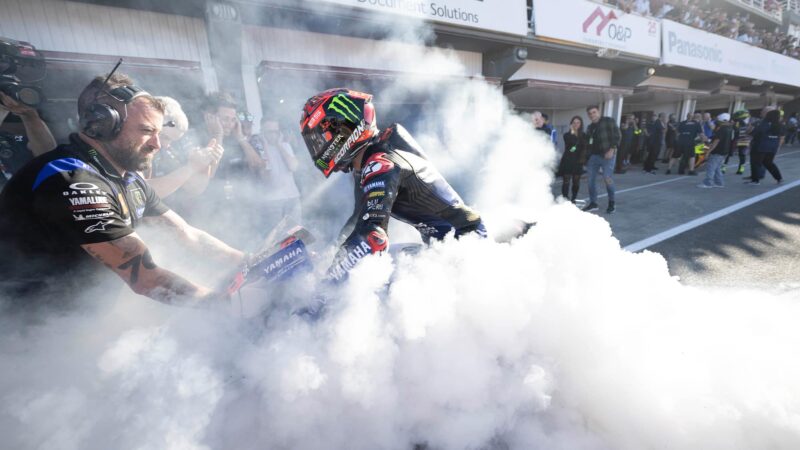
Quartararo making smoke signals to Iwata: “I need more horsepower!”
Yamaha
Of course his M1 didn’t give him the best of starts from row two. Fifth into Turn 1, he tried to ride around the outside of Marc Márquez at the next corner, which obviously didn’t work, stood up Jack Miller a few corners later to take fourth, only for the Ducati to blast past him on the straight. Quartararo out-braked Miller into Turn 1, then Miller returned the compliment at Turn 2, pushing the Frenchman wide, allowing Bagnaia through, the title contenders colliding which lost Bagnaia his lower right winglet, which nearly clouted runner-up Brad Binder.
“It didn’t hit me, because I ducked!” laughed the KTM man, who used a revised chassis (with different stiffness) for the first time, which fixed many of the RC16’s turning issues.
“I’ve been requesting more drive grip all year and they brought it here,” said the 27-year-old South African who finished four tenths down on Rins, after being seventh and 1.1 seconds down after the first lap. “It was so difficult to pass with a full fuel tank, but once the load came down I could brake later and make some moves. The new chassis was tricky to figure out – it’s a lot more difficult to stop and the front moves a lot, but when I pick up the bike I have better drive grip. It was so cool at the end – I could change my riding style a bit and prepare the exit of the corners and take an advantage, where normally I’d start spinning and I wouldn’t go forward.”
At least Quartararo had clipped Bagnaia’s wings but it wasn’t enough. The pair battled back and forth for the next few laps, their duel allowing the leading quartet to disappear out front, two second ahead by half-distance.
Quartararo did everything he knew how, and more, to close that gap, riding his M1 above and beyond the limit, as he’s done so often this year, the bike shuddering and shaking as he tried to create more than his engineers had given him.
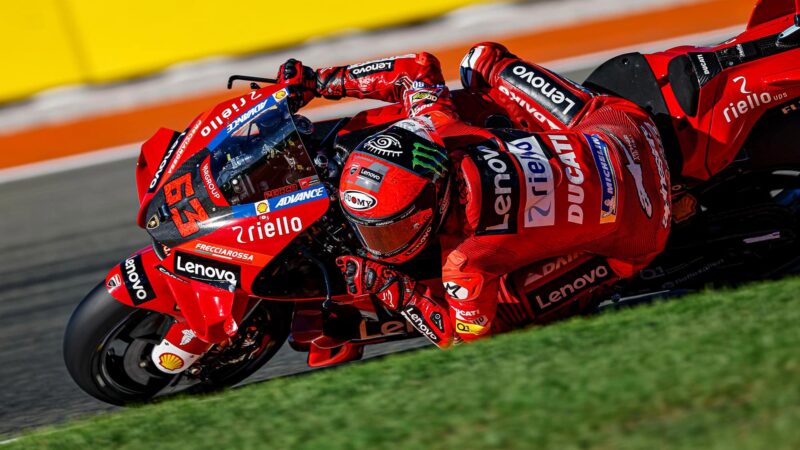
Bagnaia was precision personified, except when he wasn’t. He came back from five crash DNFs to win seven races and the title
Ducati
By lap 17 of 27 he had the gap down to four tenths but that was as good as it got, because the warmer-than-expected weather had turned the left side of his front tyre into “chewing gum”. And anyway, even if he caught the group he still had to overtake Rins, Martin and Miller for the win (because Márquez had already hit the deck by that point, giving Honda its sixth winless year in 42 seasons), so he might as well have been Evel Knievel planning to jump the Grand Canyon.
“Impossible isn’t word,” someone once said. But they were wrong.
Quartararo was disappointed not to win the title but not that much. “I have no regrets,” he said. “I tried my 100% even though we had the front tyre problem.”
The 23-year-old Frenchman was a wonder to watch throughout 2022, magicking lap times out of his M1 which no one else could get close to. Modern MotoGP is all about preparing yourself 100% in every area: technically, physically and mentally.
At Valencia we saw Quartararo using EFT (emotional freedom technique) tapping therapy, which had him rhythmically tapping his body before qualifying, to reduce stress and negative emotions.
He’ll need more than EFT in 2023, what he really, really wants is more BHP.
Yamaha has been working since earlier this year to design a 2-23 M1 engine, after years of usually having the slowest bike on the MotoGP grid. In February the company hired Italian Formula 1 engineer Luca Marmorini, who used to work for Ferrari and Toyota.
But I can’t stop wondering why Yamaha didn’t try a different angle of attack in May, when Suzuki announced its decision to quit MotoGP.
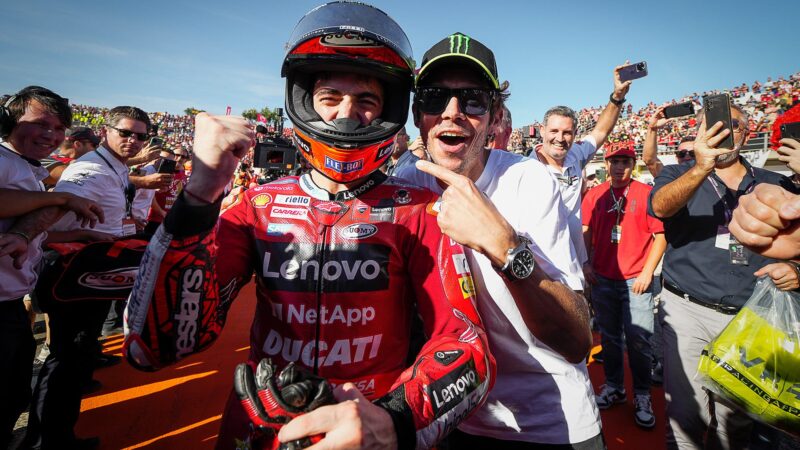
One year after Rossi retired his number-one VR46 rider won the academy’s first MotoGP crown!
Dorna
Yamaha’s Iwata HQ is ten miles/16km from Suzuki’s Hamamatsu HQ. So why not quietly find out who designed the GSX-RR engine, drive to Hamamatsu, offer those engineers five times what they’re already earning and get them to build an M1 engine? Surely they know more about what’s required from a MotoGP engine than a Formula 1 engineer does?
Marmorini has come up with four different specs of M1 engine, all of which were tried by Yamaha’s test team at Jerez a week or so ago, and some of which will be evaluated by Quartararo and troubled team-mate Franco Morbidelli at Valencia tomorrow.
It’s not easy to get winning power out of a MotoGP engine these days, when the best are knocking on 300 horsepower. The biggest gains aren’t gained via combustion improvements, but by reducing friction and pumping losses.
Whatever Marmorini does, Quartararo and Morbidelli won’t have an easy time next year, when they’ll be the only riders on inline-fours, surrounded by 18 V4s, most likely making more horsepower.
One of those V4s will be the Desmosedici GP23 of deserved 2022 MotoGP king Bagnaia, who won the premier-class championship like no one had ever one before. Coming back from 91 points down and five crash DNFs to win the title.
It took a very special mind and the very special support of the VR46 brotherhood to maintain Bagnaia’s composure after he had crashed out of June’s German GP, his fifth crash from the first ten of 20 races.
Most riders would lose their minds after such a disastrous run. Instead Bagnaia went out and won the next four, reducing the gap on Quartararo to 31 points, with six races to go.
Sure, Bagnaia had the better bike, but so did several other Ducati riders. Every MotoGP machine has its good points and its bad points – the objective is to maximise the positives and minimise the negatives by adapting your riding technique, from track to track and from corner to corner.
Bagnaia occasionally got some help from his Ducati allies, like in Thailand. Other times he had to race them to the bitter end, like in Malaysia where Enea Bastianini pushed like a bastard and yet Bagnaia didn’t give in because he knew he needed every point he could get. And don’t forget that he had started the season with a bike that didn’t do what he wanted it to do, hence so many grim results and tumbles.
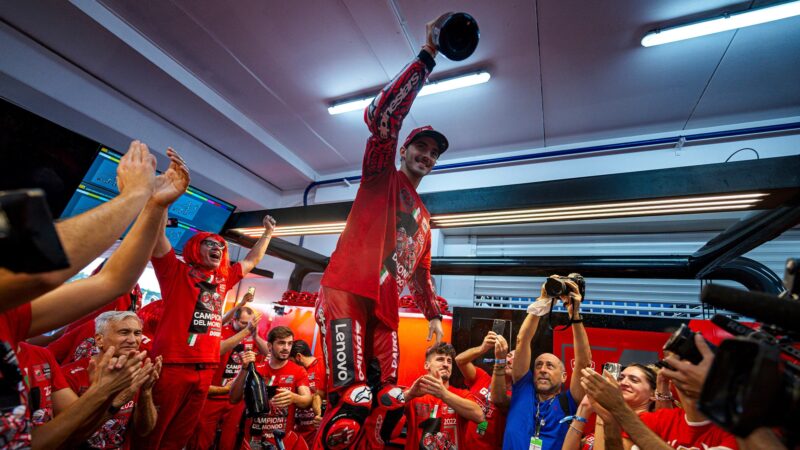
Bagnaia and the Ducati team: well-deserved title celebrations after a 15-year wait
Ducati
The 25-year-old Italian was clear favourite to win the title at Valencia, but of course that made him even more nervous.
“It was my worst race of the year!” said the former Moto2 world champ, who took the title from Quartararo by 17 points. “At the finish line when I saw my pitboard saying I was world champion, everything was lighter and nicer. It wasn’t easy because after the fight with Fabio I lost a winglet and from then it was nightmare because trying to stay on the right lines was very, very difficult.”
“When I crashed in Germany I lost faith in winning the championship, but only for a short while and then I knew there was a chance. The work we’ve done in the second part of the year was incredible. We analysed everything: why I was crashing and making mistakes and from that moment we did something incredible.”
Seven victories and three further podiums – starting from the sixth race – changed everything, with lots of help from the VR46 academy and Rossi himself, who was at Valencia, examining Bagnaia’s data and giving him pep talks.
“I felt a lot of weight on my shoulders to give this title to Ducati,” he added. “Yesterday I spoke to Vale. He said, ‘You have to be proud that you have this possibility to win the title, because not many can have the same feeling. It’s true that you feel pressure, anxiety and fear, but you have to be proud, happy and try to enjoy it’. I tried to enjoy the race but it didn’t work!
“It’s not just the influence of Vale, it’s all the guys who work for us in the academy. If one day I say I want to ride pocket bikes at the track, they organise everything. If I want to go to Portimao to have a test on my Panigale before the season they organise everything. The passion is incredible and at home all the VR46 riders work together and push each other to improve ourselves.”
It was perhaps a shame that Ducati didn’t paint Bagnaia’s and Miller’s bikes in metallic silver, to celebrate the 50 years since Bruno Spaggiari took Ducati’s first MotoGP podium at Monza on the factory’s first v-twin (albeit lapped by Ago’s MV triple)
That result was hugely significant for Ducati, because the 500 was Ducati’s first v-twin, so it was the start of the 90-degree vee Ducatis we know today. It was also the father of the GT750 and the grandfather of the first water-cooled eight-valve 851 v-twin, which begat the 888, 916, 996, 998, 999, 1098, 1198 and 1199 superbikes, which were the sound and colour of World Superbikes from its inaugural season in 1988 until the Panigale V4 arrived two decades later.
Ducati’s first WSB success probably saved the company from extinction, so yesterday’s MotoGP success marked a hugely importation half-century anniversary for the Bologna marque.
The past is a foreign country, but not that foreign.

